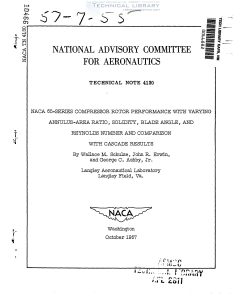naca-tn-4130
- Version
- 125 Downloads
- 2.34 MB File Size
- 1 File Count
- February 2, 2017 Create Date
- February 2, 2017 Last Updated
National Advisory Committee for Aeronautics, Technical Notes - NACA-65-Series Compressor Rotor Performance with Varying Annulus-Area Ratio, Solidity, Blade Angle, and Reynolds Number and Comparison with Cascade Results

A typical axial-flow compressor rotor using NACA 65-series compres-
sor blades was tested at low speeds and its performance was measured over
a range of quantity flow rates at several values of annulus-area ratio,
blade-setting angle, solidity, and Reynolds number to compare with porous—
wall cascade results. The data obtained with the annulus area varied were
corrected to the two-dimensional-flow condition by two methods. From the
results of this study, the conclusion was reached that two-dimensional-
flow porous-wall cascade results can be used to estimate rotor performance
with good accuracy over a wide range of conditions. The mean—axial-
velocity method of converting the rotor data to two-dimensional-flow con—
ditions gave good agreement with cascade data for axial-velocity changes
across the rotor as large as 15 percent. The rotor performance changed
only slightly as the Reynolds number was decreased from 500,000 to 250,000.
As the Reynolds number was decreased below 250,000, decreases in rotor
efficiency, pressure-rise coefficient, and turning angle were observed.
The performance of axial-flow compressor blades can be quickly and
accurately measured in detail.by using stationary models in two-dimensional-
flow cascade wind tunnels. The cascade tunnel can thus be a very useful
instrument for providing information needed in the design of axial-flow
compressors. Questions often arise as to whether two-dimensional—flow
cascade data can be applied directly to compressors and what corrections,
if any, must be made. In the investigation reported in reference 1,
rotor-blade surface pressure distributions and air-turning—angle values
were found to be similar to those measured in porousdwall cascade tests
at design angle of attack. The present investigation was devised to ’
provide information concerning the effect on rotor efficiency, static—
pressure and total-pressure rise, and turning angle of changes in blade
angle, solidity, flow rate, Reynolds number, and annulus area through
the rotor. The performance of the rotor as estimated from cascade data
was calculated and is presented for comparison.
An axial—flow compressor rotor having blades of camber, solidity,
and hub-tip radius ratio typical of a centrally located rotor in a multi-
stage compressor was investigated at low speed in a 28—inch test compres—
sor without guide vanes or stators. Surveys of the flow made immediately
upstream and downstream of the rotor were used in calculating the perfor-
mance for comparison with values estimated from porous-wall-cascade test __ _
results.
| File | Action |
|---|---|
| naca-tn-4130 NACA-65-Series Compressor Rotor Performance with Varying Annulus-Area Ratio, Solidity, Blade Angle, and Reynolds Number and Comparison with Cascade Results.pdf | Download |

Comment On This Post